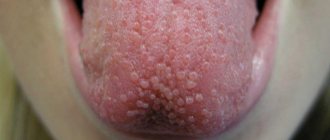It happens that unpleasant inflammations appear on the tongue, causing discomfort and pain. This happens often; almost every person has encountered this phenomenon at least once in their life.
Typically, the papillae on the tongue become inflamed due to external factors, and are characterized by their transience. But it happens that such a reaction of the tongue mucosa is provoked by internal factors, and is a symptom of a serious disease.
This article will tell you how to figure out what problem the patient is dealing with and help the tongue papillae return to normal as quickly as possible.
Causes of inflammation of the papillae on the tongue
Conventionally, the reasons that caused inflammation of the papillae of the tongue can be divided into 2 groups:
- The mucous membrane of the tongue can be damaged by gastric juice
mechanical (obtained as a result of mechanical action on the tissues of the tongue);
- internal (when inflammation of the receptors occurred as a result of diseases caused by pathogenic microorganisms and their metabolic products).
Mechanical reasons include:
- burns from chemical compounds (acids, alkalis, alcohols);
- burns from thermal effects (excessively hot food or drinks);
- the mucous membrane is damaged by gastric juice (most often this occurs during vomiting or reflux esophagitis, when gastric juice with food particles is thrown into the esophagus; gastric juice has a very acidic environment, which causes a chemical burn);
- mechanical damage from direct contact with an irritating object (for example, when sucking candy or from constantly eating food with a rough surface);
- household injuries, including damage to tongue tissue from hygiene items or accidental biting;
- when brushing your teeth aggressively: the bristles of the toothbrush injure the mucous membrane of the tongue;
- regular injuries resulting from sharp chipped teeth, unsuccessfully placed dentures or fillings;
- too spicy or salty food;
- stress and depression as factors that weaken the body's immune system.
Other reasons include:
- Language structure
diseases localized in the oral cavity (and caused by fungi, various bacteria and some types of viruses, including the herpes virus);
- allergies;
- uncontrolled or very long-term use of antibiotics;
- such systemic diseases as: scarlet fever, measles, diphtheria, anemia, disruptions in the gastrointestinal tract;
- avitaminosis;
- decreased immunity.
Important! It is necessary to distinguish between such types of inflammation of the papillae as papillitis and glossitis. Papillitis occurs as a consequence of mechanical damage, and glossitis - as a consequence of pathogenic processes.
Development of pathology
The most complex forms of progressive inflammation of the gingival papillae are gingivitis and periodontitis. The most common in dental practice is catarrhal gingivitis, which has symptoms similar to advanced inflammation and can lead to changes in the shape of the gums and deterioration of health on an ongoing basis.
Ulcerative gingivitis is a pathology that provokes the death of gum tissue and inflammatory processes in the lymph nodes. One of the reasons for its occurrence is hypothermia of the oral cavity, in combination with bacteria leading to the formation of gray plaque on tissue areas. Treatment of the disease must begin in the early stages, otherwise it can develop into severe purulent inflammation.
Hypertrophic gingivitis is characterized by accelerated growth rates of cellular tissues of the basal and connective group. The cause is a disruption of hormonal levels and normal metabolism in the body. In the absence of therapy, thickened tissues begin to keratinize and thicken, causing pain and discomfort.
Periodontitis is the formation of a temporary cyst in the upper area of a tooth susceptible to pathology. Purulent accumulations form in the cavity, causing swelling and pain. The process can be caused not only by bacteria, but also by pulpitis, as well as by an incorrectly performed dental prosthetic procedure.
Symptoms
The patient may experience discomfort in communication due to impaired diction and thickening of the upper layer of the epithelium of the tongue
The main symptoms of inflammation of the papillae on the tongue are their redness (hyperemia) and soreness (or itching).
There are also disruptions in the perception of the taste qualities of food and drinks and their temperature conditions.
As a result of inflammation, the patient may experience discomfort in communication due to impaired diction and thickening of the upper layer of the epithelium of the tongue.
You can distinguish papillitis from glossitis by looking at the back of the tongue: if there is no plaque on it, this means the inflammation is non-infectious.
Also, the symptoms of papillitis tend to disappear within a few days without medical assistance, since a feature of the mucous membrane of the tongue is its rapid recovery.
Sometimes an infection is associated with papillitis, but this is considered a complication and goes into the category of glossitis.
External manifestations
If you look closely at the painful area, the inflamed papillae can be easily identified. They increase in size and change color, becoming soft pink, deep red or completely white (with candidiasis).
Thread-like stretched along the edges of the tongue. Their number is greatest, their function is to touch and hold food in the mouth, they do not perceive taste
Tongue pain
General information
The tongue is a muscular organ covered with a mucous membrane with lymphoid formations and glands. The tongue is richly supplied with nerves and blood vessels. It performs a wide variety of functions:
- participates in pushing food;
- sucking function;
- is an organ of speech;
- responsible for touch;
- determines temperature and taste.
The tongue consists of a root, a body and an end. When the mouth is closed, it occupies almost the entire oral cavity.
The upper surface of the tongue is called the dorsum. Along it there is a groove, under which there is a thin fibrous septum in the form of a plate of dense silvery tissue, dividing this organ into two equal halves. The mucous membrane of the lower surface of the tongue is much more delicate and thinner than the upper one, and is rich in superficially located thin blood vessels-capillaries. This ensures rapid absorption of some medications placed under the tongue. Along the midline from the root of the tongue towards the chin, a thin fold of the mucous membrane, called the frenulum of the tongue, is stretched. There is a small elevation on each side of the bridle. The elevation is called the hyoid caruncle. The excretory ducts of the salivary glands open on the caruncles .
The unique anatomical formations of the tongue are the papillae, which cover the anterior part of its back by two-thirds. They not only perform a variety of receptor functions, but also actively respond to various local and general diseases, which will be discussed in the relevant sections of the brochure. In humans there are six types of tongue papillae , the most important of them functionally are:
- threadlike,
- mushroom-shaped
- leaf-shaped,
- groove-shaped.
Fungiform papillae are less numerous and are found among filiform papillae, mainly at the tip and along the edges of the tongue. They are pink in color, making them clearly visible against the lighter background of other papillae. Leaf-shaped papillae are located along the edges of the posterior part of the body of the tongue and consist of five to eight vertical folds. The circumvallate papillae are the largest, numbering seven to twelve, arranged in two lines converging to the median sulcus almost at a right angle, open anteriorly, closing the papillary zone of the tongue behind. The papillae of the tongue contain a large number of superficially located nerve endings. The richest in them are the grooved and mushroom-shaped papillae. Behind the papillary zone, on the back of the root of the tongue, there are lymphatic follicles that form the lingual tonsil. In the tongue, bundles of four skeletal muscles, starting on the bones of the skull, and four intrinsic muscles, running in different directions, and four intrinsic muscles are closely intertwined, which ensures exceptional mobility of this organ. Causes of tongue pain: Mini-traumas are the most common causes of tongue pain:
- The tongue can become sore even in the absence of any injury. Lymph nodes in the sublingual area can become enlarged as a result of infection or even some types of cancer.
- Pain in the tongue can occur due to diseases of the salivary gland.
- Tongue pain can also be a symptom of various types of allergic reactions, iron deficiency in the body, or side effects when taking certain medications.
Sometimes a possible cause of tongue pain is a viral sore , a painful tissue lesion that appears on the tongue (or anywhere else in the mouth) for no apparent reason. Some doctors think that these viral sores (painful stomatitis) are the result of emotional stress, fatigue, or decreased body resistance. Glossalgia is pain in the tongue that occurs mainly in women over 25-30 years of age. The causes and mechanism of development of pain in the tongue have not been fully elucidated. Glossalgia often occurs when:
- diseases of the gastrointestinal tract,
- dysfunction of the endocrine system,
- neurogenic disorders.
Often the occurrence of glossalgia is preceded by mental trauma. Glossalgia manifests itself as a burning sensation, tingling, a feeling of rawness in the tongue, fatigue of the tongue after speaking, difficulty in moving it, and, less often, pain. Sometimes the pain spreads to other parts of the oral cavity (lips, gums, cheeks), and even less often beyond its limits. The pain may disappear while eating.
Glossitis is a superficial or deep inflammation of the tissues of the tongue. Glossitis can be an independent disease, but more often it is a symptom of some general disease of the body. With deep glossitis, the inflammatory process is localized in the thickness of the tongue and clinically manifests itself in the form of an abscess or phlegmon .
Phlegmonous glossitis, spreading to the bottom of the mouth, causes acute inflammation in the chin area and neck. Treatment occurs surgically. Superficial glossitis is a catarrhal inflammation of the mucous membrane of the tongue and refers to local manifestations of inflammation of the oral mucosa. As an independent disease, catarrhal glossitis is extremely rare, and the causes of its occurrence can be:
- carious teeth;
- difficult teething;
- Tartar deposits;
- injury to the mucous membrane of the tongue;
- smoking;
- lack of oral care;
- intoxication with salts of heavy metals.
Catarrhal glossitis can be one of the symptoms of diseases of the gastrointestinal tract and infectious diseases (measles, scarlet fever, diphtheria). In such cases, it is a valuable diagnostic sign.
Catarrhal glossitis is characterized by the appearance of:
- thick coating on the tongue;
- swelling of the tongue;
- restriction of tongue mobility.
Patients complain of a burning sensation in the tongue, mild soreness, loss of taste, and excessive salivation. Often a sign of ulcerative necrotizing stomatitis, which develops under the influence of a mixed infection (yeast-like fungi, protozoa, fusospirillary infection), is ulcerative glossitis. A dirty gray coating forms on the tongue of such patients; when removed, painful and bleeding erosions and ulcers are visible. Hypersalivation and bad breath are noted
Other causes of tongue pain
There are a great many causes of pain in the tongue, and only a specialist can determine the true cause of the pain. Pain in the tongue, in particular, may indicate the following diseases:
- lichen;
- ill-fitting dentures;
- tongue injuries;
- anemia due to lack of iron or vitamin B12;
- smoking irritates the tongue and makes it painful.
If you don't understand what's causing your tongue pain and the discomfort continues, have your doctor or dentist take a look at it. Sometimes small tumors , invisible to you, develop on the undersurface of the tongue. If neither you nor the doctor can find anything on your tongue to explain the pain, it's probably neuralgia: stimulation of the nerves that supply the mouth. You feel pain in your tongue, but it may actually be coming from nearby teeth and gums. If tongue pain occurs when you walk quickly and stops when you rest, the cause is in the heart. Persistent tongue pain should be brought to the attention of your family therapist. Ultimately, it may be associated with a minor infection or irritation.
Localization
An important role in making a diagnosis and finding out the cause of the disease is its localization. The localizations of inflammation of the papillae, as well as the possible causes of their appearance, will be listed below.
In all languages
Inflammation of the papillae throughout the tongue may indicate a chemical or thermal burn, as well as the infectious nature of the disease.
Inflammation of the papillae throughout the tongue may indicate a chemical or thermal burn
On the root
If the problem area is the back of the tongue (root), then the patient will experience difficulty perceiving the bitter taste, since the inflammation will affect the grooved papillae responsible for this.
A popular cause of this localization of inflammation is an allergic reaction, with the patient noting increased salivation and swelling of the tissues, including the soft palate that may react with swelling.
The cause may be diseases associated with the gastrointestinal tract, or malfunctions in its functioning (for example, too low or high acidity). Also, it is on the root that fungal and bacterial glossitis is localized.
The cause may be diseases associated with the gastrointestinal tract or malfunctions in its functioning.
On the tip
The tip of the tongue most often suffers from mechanical damage, since the tip comes into contact with too hot food and drinks, rubs against chipped teeth, and is subjected to biting.
The tip of the tongue most often suffers from mechanical damage, since the tip comes into contact with food and drinks that are too hot
Side
On the sides of the tongue there are the so-called conical, mushroom-, filament- and leaf-like structures of the tongue.
Enlargement and hyperemia of the taste buds, which are located on the sides of the tongue, most often appear due to mechanical damage to the teeth, but pathogenic microorganisms and chemical burns can also be the cause.
Inflammation on the sides of the tongue can also be caused by pathogenic microorganisms and chemical burns.
Surface structure
If cracks have formed on the surface of the tongue, this usually indicates dehydration and excessive blood thickening, which, in turn, increases the risk of stroke or thrombosis. Also, a dry surface with numerous small cracks is one of the symptoms of diabetes. But depending on their location, cracks can indicate different diseases. For example, one deep one in the middle of the tongue can be a symptom of an upset digestive system and high acidity in the stomach.
A spotted or raised tongue may indicate that a person has fungal infections, vitamin deficiency or allergies.
Sometimes such changes appear in people with vitiligo or psoriasis. But if a curved line is clearly visible on the surface, then the musculoskeletal system should be checked; this may be a signal of a spinal disease.
Diagnostics
If the patient has inflamed papillae on the tongue and the symptoms do not go away within a day or two, if the symptoms worsen, if they are pronounced, and the points of inflammation themselves are very painful, then you need to consult a dentist.
The dentist will conduct an examination on the following points:
- If the presumptive diagnosis is associated with diseases of the internal organs, then additional consultation with other specialists will be required.
assess the color, shape and size of problem areas;
- determine whether there is swelling;
- check the tongue for mechanical tissue damage;
- examine the surface of the tongue for plaque; if it is detected, it will evaluate its location, color and quantity;
- check the tongue for the presence of ulcers or eczema;
- Assess the condition of the oral cavity as a whole.
The following tests may be required to make a diagnosis:
- Smear for histology;
- Tongue sensitivity testing;
- Blood sampling for general analysis and biochemistry;
- Blood test to exclude HIV, AIDS, hepatitis virus, syphilis and other pathogenic elements.
If the presumptive diagnosis is associated with diseases of the internal organs, then additional consultation with other specialists (gastroenterologist, dermatologist, endocrinologist, immunologist, ENT) will be required.
What does a healthy tongue look like?
The tongue is pale pink - absolutely healthy.
Diagnosis by the appearance of the tongue was mastered by ancient healers, who believed that a disease could not be considered cured until the patient’s tongue regained its previous appearance. The tongue of an absolutely healthy person has the following signs:
- Pale pink color;
- Small taste buds without pronounced features;
- No bad breath;
- Be moderately moist;
- The presence of a small amount of translucent bright pink coating is allowed;
- There is no unpleasant odor.
If you deviate from these signs, you should consult a general practitioner or gastroenterologist and undergo the examination prescribed by him.
Treatment
If after a couple of days the symptoms have not disappeared or, on the contrary, have intensified, rush to the dentist
If the papillae are inflamed, but the cause is difficult to determine, then first of all, rinse your mouth with an antiseptic solution.
If after a couple of days the symptoms do not disappear or, on the contrary, intensify, rush to the dentist.
After conducting the diagnostics, he will make a diagnosis and either refer you to another doctor or describe how to treat the problem.
Typically, treatment consists of antiviral (acyclavir, Zovirax) and antihistamine (suprastin, tavegil) drugs, antibiotics (clorsacillin, clindomycin) and antifungal agents (chlorhexidine, furacelin, miramistin).
If you can’t see a doctor, you can improve your condition at home.
The following methods are effectively used for this:
- You can apply ice (or chew it) to relieve swelling.
- Regularly rinse your mouth with a baking soda solution (15 grams of baking soda per 1 glass of lukewarm water) - this will help relieve inflammation and reduce swelling.
- Lubricate the problem area with honey - this product is famous for its antibacterial properties, and it will also help relieve swelling and promote tissue regeneration.
- Drink natural yogurt - it will help restore normal oral microflora if the problem lies in its disturbances.
What to do if your tongue hurts?
If you experience pain in any area of the tongue, you should make an appointment with a dentist or otolaryngologist. Before going to the clinic, it is necessary to exclude the presence of minor injuries or accidental burns, for which it is important to leave time to heal. If the cause of the pain was a cosmetic puncture, you must strictly adhere to all recommendations and carefully monitor oral hygiene. If your tongue hurts without punctures or wounds, you should consider one of the following options:
- Carrying out dental procedures
with surgery: anesthesia and medical procedures cause swelling of the gums and a small area of the tongue. The discomfort usually goes away as the swelling decreases.
- Inflammatory and fungal diseases of the oral cavity
eliminated by taking antifungal agents and maintaining constant cleanliness in the mouth.
- Inflammatory and infectious diseases of the upper respiratory tract
: sore throat, sore tongue - signs of inflammation of the tonsils or submandibular lymph nodes. The otolaryngologist will draw up a treatment regimen with the prescription of antiviral, painkillers and antihistamines.
Are you worried about short-term or constant pain in different areas of the tongue?
Try to find out the causes of discomfort, remember cases of injury or accidental burns. If pain continues to bother you, you should immediately consult a therapist, dentist or otolaryngologist. An experienced doctor will conduct all the necessary studies and take tests to accurately determine the diagnosis and create an effective treatment regimen. This article is for informational purposes only, please consult your doctor for details! Ask your doctor about contraindications and side effects.
Features of child treatment
Even with papillitis, you can catch a serious complication
If a child complains of pain in the tongue, and you notice redness of the papillae, brush the baby’s teeth, ask him to rinse his mouth thoroughly, and go to the dentist.
The child’s immune system is not yet strong enough to cope with inflammation on its own.
Even with papillitis, you can catch a serious complication, since a curious child explores most objects from the surrounding world using the oral cavity.
Clinical picture
The onset of pathology may be indicated by the appearance of redness and swelling in the affected area. If timely treatment is not started, inflammation spreads to healthy tissue areas, which leads to bleeding, discomfort, and itching.
The gum begins to cover more of the length of the tooth than usual. In the absence of qualified dental care, a change in the shape of the gingival papilla is often observed, and in advanced situations, the gum covers almost half of the element of the dentition.
The listed signs are accompanied by pain, bleeding (especially during and after eating), and a decrease in the quality of chewing function.
Among other characteristic features it is worth highlighting:
- Formation of purulent foci in the space between the teeth.
- The appearance of an unpleasant odor.
- An increase in the volume of soft tissue around the tooth.
- Difficulty eating.
- Uncharacteristic shade of the mucous membrane at the site of the lesion.
- Increased sensitivity.
- Uncharacteristic tissue structure.
In advanced cases, the inflammatory process is complemented by various diseases of the oral cavity, which lead to the destruction of both soft and hard tissues.










